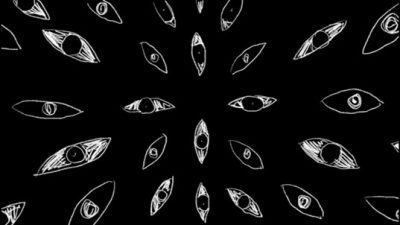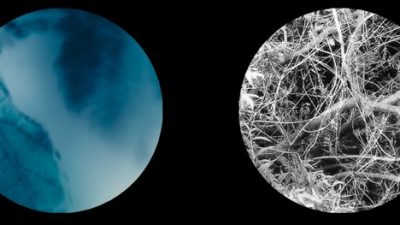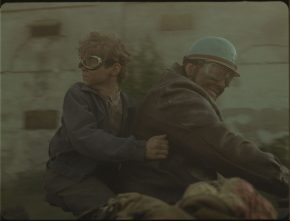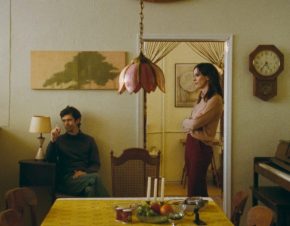What does it take to be remembered as “La Divina”? A voice that soars like no other, or perhaps a life so steeped in drama that it feels like the perfect opera? Maria Callas, the woman behind the legend, has left an indelible mark on the world, and her story is now being revisited in a grand way.
As part of the centenary of her birth in 2023, her story continues to captivate audiences in unexpected ways. From the sparkling halls of Teatro alla Scala to the silver screen, where Angelina Jolie will portray her in an upcoming biopic, Callas remains an enigma whose life and art defy the passage of time. Both the Fantasmagoria Callas exhibition and Pablo Larraín’s latest film are inviting us to delve deeper into the life of the woman who became synonymous with opera’s grandeur. But what is it about Callas that keeps us coming back for more?

Callas at the MET
Special thanks to Gabriella Ragozzini for providing access to behind-the-scenes insights to the Scala and Callas, which greatly enriched my research and review.
Rise of La Divina
Maria Callas was not just an opera singer; she was a force of nature, someone who could not have been ignored. Born in Manhattan in 1923 to Greek immigrant parents, Callas’ early life was marked by hardship and a tumultuous relationship with her mother, who had desperately wanted a son. Callas once remarked, “It is a cruel thing to make a child feel ugly and unwanted… I’ll never forgive her for taking my childhood away.” Her mother’s attempts to sell her as a prostitute in her youth were just one of many traumas that would shape Callas into the fiercely independent and driven artist she became.
At just 13, she was taken to Greece, escaping a life that had already begun to wear her down. Her refuge was the Greek National Conservatoire, where she quickly revealed herself to be a prodigy. There, her tutor Maria Trivella was struck by the young girl’s dedication. Trivella recalled, “She studied five or six hours a day. Her progress was phenomenal.” This obsessive commitment to her craft was evident in every performance Callas gave, it is what allowed her to rise from the ashes of her troubled childhood.
Callas’ public debut in 1938 with a scene from Tosca was the beginning of a meteoric rise. By the 1940s, she was already performing at major opera houses around the world, including the Metropolitan Opera in New York and the Arena di Verona. However, it was her time at Teatro alla Scala in Milan (1950-1961) that truly cemented her place in the pantheon of opera legends. She took part in over two dozen productions of the theatre.
Teatro alla Scala: The Jewel of Milan
Teatro alla Scala, more commonly known simply as „La Scala”, was built in 1776 on the site of a demolished church. La Scala was financed by Milan’s wealthiest families. These patrons did not just contribute money; they effectively owned the place.

La Scala is much more than an opera house—it is a symbol of Italian culture, a place where history, art, and politics have intersected for centuries. From the very beginning, it was the playground of Milan’s elite. Owning a box at the Scala was not just about enjoying opera; it was a statement of power and influence. In the early days, the boxes were private spaces where the wealthy would entertain guests, conduct business, and even engage in scandalous affairs, often with little regard for the performances taking place below. They treated their boxes as their private property, and those who did not have a box at the Scala, did not belong to the city’s real elite. Originally, the main floor was primarily used as a dance floor and had no chairs, once the theatre became public, the cheapest ticket owners could watch the performance from there, standing.
La Scala has always reflected the social and political currents of its time. During the Napoleonic Wars, for example, the theatre was a hotbed of nationalist sentiment. Performances of Italian operas would often be interrupted by shouts of “Viva l’Italia!” from the audience, as the people of Milan expressed their desire for independence from foreign rule. La Scala has always been more than just a venue for music; it has been a symbol of Italian identity, It was into this storied venue that Maria Callas stepped in 1951, beginning a decade-long “love affair” with the theatre that would redefine both her career and the history of La Scala.
Callas at the Scala: A Reign of Passion and Tragedy
When Maria Callas made her official debut at La Scala in December 1951, she wasn’t just stepping onto a stage; she was entering a battlefield of high expectations and fierce competition. Her debut role was in Verdi’s I vespri sicilian, she was not merely performing; she was making a statement. Her powerful voice and stage presence quickly established her as the leading soprano of her time. The productions at La Scala during the 1950s were often created with Callas in mind, and directors like Luchino Visconti, Franco Zeffirelli, and Herbert von Karajan became her artistic collaborators, helping to craft performances that would become the stuff of legend.
Visconti, a celebrated figure in film and theatre, was particularly captivated by Callas. Their collaboration on productions such as La vestale, La sonnambula, and La traviata were groundbreaking, blending Visconti’s cinematic eye with Callas’ unparalleled vocal and dramatic abilities. Together, they pushed the boundaries of opera, creating performances that were not only musical triumphs but also visual and emotional masterpieces. Visconti claimed that he only started directing operas because of Callas.
Perhaps the most famous of these collaborations was their 1955 production of La traviata, where Callas’ portrayal of Verdi’s protagonist; Violetta became the stuff of legend. The role seemed to fit her like a glove, not just because of her vocal prowess but because of the intense, often tumultuous emotions that defined both her life and her performances. The life of Maria and Violetta merged quietly.

Callas’ time at La Scala wasn’t just about artistic triumphs, though. It was also a period of personal upheaval. In 1957, she met the Greek shipping magnate Aristotle Onassis at a party thrown in her honor by Elsa Maxwell. She was immediately dazzled by him. Their affair, which led to the end of her marriage to Giovanni Battista Meneghini, consumed her life. By 1959, she had left her husband and, not long after, her career.
The mystery surrounding Callas’ relationship with Onassis has only added to her legend. There are still unanswered questions about whether Callas and Onassis had a child who died shortly after birth or if Callas had at least one abortion during their affair. What is clear, though, is that the relationship took a heavy toll on her. Franco Zeffirelli, who worked closely with Callas, once asked her in 1963 why she had not been practicing her singing. Her response was telling: “I have been trying to fulfill my life as a woman.” This personal struggle, combined with a mid-career weight loss and the physical challenges that came with it, led to a decline in her vocal abilities and eventually, the premature end of her career.
Callas’ relationship with Onassis was as passionate as it was destructive, and it ultimately led to a decline in her vocal abilities and a premature end to her career. Onassis, without saying a word to her, left to marry former US First Lady, Jackie Kennedy in 1968. Callas only got to know about this from the papers. The Onassis-Callas romance never really ended though, as the man frequently paid visits to the diva’s Parisian apartment. Biographers claim that despite his behavior “he kept coming back for Callas, as they continued to love each other” and „she nurtured her like nobody else”.
By the time Maria was 40, the woman who had once ruled the world’s opera stages was living pretty much in seclusion in Paris, her voice all but silenced. In 1977, she died of a heart attack at the age of 53, while playing cards in her living room.
Fantasmagoria Callas
To honor Maria Callas on what would have been her 100th birthday, Teatro alla Scala has unveiled Fantasmagoria Callas, an exhibition (curator: Francesco Stocchi) that is as much a tribute to her artistry as it is an exploration of her enduring mystique. Running from November 2023 to September 2024, the exhibition is a collaboration between contemporary artists and curators, each bringing their own interpretation of Callas’ life and influence.

Scala Museum
The exhibition is divided into five stages, each representing a different artistic expression. It begins with a haunting installation by composer Alvin Curran, who has created a meditative space where visitors can sit in a dark room, illuminated by soft blue lights, and listen to recordings of Callas’ voice. The installation, designed to be an immersive experience, allows visitors to lose themselves in time and space. It is a reminder of the sheer power of Callas’ voice, which could convey more emotion in a single note than most people could in a lifetime.
The next stage is an installation by artist Latifa Echakhch, who explores Callas’ stage presence. Her installation features a curtain made of white and red pearls, behind which the silhouette of Callas is revealed. The pearls represent tears and blood, symbolizing the fragility and strength that coexisted within Callas. What is more, the exhibition has sparked some mischievous behavior from its youngest visitors. Children often pocket pearls as keepsakes.
Director Mario Martone contributes an installation that delves into a little-known moment in Callas’ life—a brief but profound meeting with Austrian poet Ingeborg Bachmann during a rehearsal of La traviata in 1956. Though the encounter lasted only minutes, it left a deep impression on Bachmann, who saw in Callas a woman of inner strength and vulnerability. Unfortunately, both Sonia Bergamasco’s performance and the short film itself, go melodramatic and quite cheesy, making this chapter of the exhibition the weakest link.
The fourth stage of the exhibit is Francesco Vezzoli’s installation – a playful visual tribute to Callas’ persona. It features her face, laser-printed on canvas, repeated sixty-three times, each adorned with blue sparkling embroidery that recalls stage makeup. This repetition emphasizes the multiple facets of Callas’ identity—the diva, the artist, and the woman behind the legend. And in each still photograph, the eyes of Callas say more than a thousand words. Vezzoli, a devoted Callas researcher himself, uses this repetitive imagery to emphasize the many layers of Callas’ identity, and boy, he does it perfectly.
The exhibition concludes with a stunning magenta red evening dress designed by Giorgio Armani for his Privé 2021 collection. It is a fitting finale to an exhibition that captures the mysticism and otherworldly aura of La Divina. Suspended in the darkness, the dress floats with elegance, while “setting the room on fire”. This final stage by Armani, like Callas herself, is a blend of the sublime and the surreal. Though they have never met, the world-famous designer claims “Milan played a key role in my life, just like in that of Maria. I believe this city is the intersection of our lives.”
Angelina Jolie as Maria: The Final Act of Larraín’s Trilogy
As if the Fantasmagoria Callas exhibition was not enough, 2024 will also see the release of Maria, a biopic directed by Pablo Larraín and starring Angelina Jolie as the iconic soprano. Larraín, known for his intense psychological portraits in El Conde (2023) and Spencer (2021), brings his unique vision to the life of Callas in what is being described as the final installment of his “Lady with Heels” trilogy. The film, set to premiere at the 81st Venice International Film Festival this fall, where it will compete for the coveted Golden Lion, promises to explore the final days of Callas’ life in 1970s Paris—a period marked by solitude, regret, and lingering echoes of her once-great voice.

Source: People
The irony in Larraín’s choice of subject is striking. Just as Jackie delved into the inner turmoil of Jacqueline Kennedy following the assassination of her husband, now “her rival” Maria is in the center of his creative efforts. Angelina Jolie, who has spoken of her deep admiration for Callas, describes the role as “one of the most challenging of her career”. The film, much like Callas’ performances, is expected to be a blend of high drama and subtle introspection.
Fantasmagoria Callas at Teatro alla Scala and Pablo Larraín’s Maria are more than just tributes; they are acts of resurrection, bringing Maria Callas back to life in ways that are as compelling as they are haunting. As we celebrate the centenary of her birth, it is clear that the legend of La Divina is far from over. In fact, it is only just beginning.
~ by Dora Endre ~

























Comments